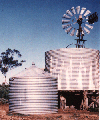 Greetings from Lindisfarne, Red Cliffs, Vic, Australia |
DRIED SULTANAS |
|
Back to the Home Page |
|
|
||
| Stars | Words | Little Pictures |
|---|---|---|
| Time Exposure |
I have scaled each photograph to be 100 pixels wide. The heights vary, as the thumbprint is in the same proportions as the original. Click on the small photo, to see the large original. For example, this time shot of our stars is 5486 bytes. The large version is 50,650 bytes and measures 330 x 250 Use the link to return to my page after admiring the large photograph. |

|
|
| ||
| Water | ||
| Our Murray River |
The Murray River is our main source of water. This slide was taken at the Red Cliffs Pumping Station, and shows the inlet pipes extending towards the middle of the river. |

|
| The Pumping Station |
The pumps in the pumping station are now powered by electricity. They lift the water in two inlet pipes, which feed into our channel system. Water is then gravity fed to each property, and originally only land lower than the top of the channels could be irrigated. There is one additional lift near the town, to provide it with water pressure. The high land was used for houses, and drying racks. |

|
| Open Channel | Water is reticulated along concrete channels about 1.8 metres deep and 5 metres wide. The boy beside the channel gives some perspective to this illustration. The empty channel has to be repaired each season. The channel is obviously dangerous for children, as well as wasteful - water leaks out, and evaporates. The channel system has been gradually replaced with an underground pipeline in most of the district (though not the Number One channel, beside our property) |

|
| Our rainfall | The climate at Red Cliffs is marginal for agriculture. Our rainfall is an average of 300 mms (10 inches) a year, but it is very erratic. We rely on water pumped from the irrigation channel into our collection of tanks for our domestic water supply. The taller tank, on the stand, gives us water pressure for our shower. The windmill was in use before electricity was connected to this area in 1951. It is easily damaged by severe winds, only works in moderate breezes, and the clack (lifting section) must be kept moist. |

|
| Watering High Land |
Andy purchased a tractor with a power drive, and installed a six inch pump to lift water up onto an acre of Ohanez vines he planted on his surplus high land. This variety of Table Grape ripens late in the season, and in the days before refrigeration was valued for its long shelf life. |

|
| Priming Inlet |
Watering the Ohanez is very much a family affair, with the trio making sure that Dad does it correctly. Barrie is checking that the top of the Primming Inlet has been fastened tightly. |

|
| Helping Mum |
The boys gladly give Mother a hand keeping the water beside the vines - they even dressed specially for the job! |

|
| The Water Wheel |
Our water wheel is in the process of being installed. It is part of the process of pipelining the property, replacing the original open ditch system, and improving our ability to control the flow of water to each side of each row of vines. In 1998 many growers have replaced furrow irrigation with either overhead or under vine spray systems. They apply half the quantity of water, and irrigate twice as often. |

|
| Block Irrigation |
Rosters of groups of about 6 growers take their allocation of about 9 megalitres in turn. Each has about three days to complete the watering of the 6 hectare property. This routine is repeated six times each year, usually in August, October, November, December, January and March. In 1998 the Roster system has been replaced by individual growers ordering their own water, without the need to co-operate as neighbours. |

|
|
| ||
| Sultanas | ||
| Winter pruning | Sultana vines bear bunches of fruit from the 4th bud outwards, along each cane. We use double trellis and try to place two canes on each of the four wires, expecting to get 80 bunches from each vine. Barrie is sorry for this vine, which has had the old 'head' cut off, and replacement canes are being trained into place. |

|
| Our crop | The irrigation water added to the sunshine and our red sandy loam soil produces a fine crop of sultanas. In Pop's day a vine was expected to produce 40 pounds of fruit. Selecting high yielding vines, and culling poor producing vines, has doubled this to the modern 40 kilograms (4 tins per vine). |

|
|
| ||
| Drying | ||
| Ready to pick | Tins are spread in each second row, for the pickers to fill and place under the vine for the cartman to load onto the trailer. Unused tins are later collected and put in rows waiting to be picked. It is very bad form to underestimate the crop and not put out surplus tins - those vines do not get harvested! |

|
| Pickers | Morning Tea, or as the workers say, Smoko. Pop is sitting at the left. The harvest team consists of our Permanent Man, who is expected to oversee the workers, and usually drives the tractor, two cart men, two rack spreaders, and twelve pickers. Pop brings the morning and afternoon teas down to the workers, also moves empty tins across to the rows being picked. Each picker expects to harvest about 200 tins each day, and earns 40 cents for each tin. More active workers fill more tins, and the growers do not mind their staff starting the day early - though slower folk may complain that all the available tins have been filled! |

|
| The hoist | Each filled tin is collected and stacked on a tray on the trailer, then taken to the diptank at the drying green. The hoist, capable of lifting each tray holding three rows of 25 tins of fresh fruit (about half a tonne), was an important labour saving device Pop installed, and kept in good repair. |

|
| Dipping | The loads of sultanas are lowered into a cold potash and oil solution, which perforates the skin, allowing the fruit to dehydrate quickly. Each tin of grapes is emptied by hand onto a tier of the rack. A worker then goes along the rack, spreading out the clumps of fruit so they will dry evenly. They try not to detach berries from the bunches - the loose berries receive a lower grade at the Packing House. |

|
| Spreading | Max and another worker are placing the fruit on the rack. Our drying racks are 100 metres long, 1.5 metres wide, and 10 tiers high. They hold 20 tonnes of fresh fruit, which dehydrates to about 5 tonnes of dried sultanas. |

|
| The Racks | When I took over from Pop, in 1972, each tonne of fruit paid the workman's wages for 10 weeks. By 1980 the price of fruit had dropped and wages had risen, so the same amount of fruit only supported the workman 3 to 4 weeks. The property ceased to be a viable business exercise, despite improvements in the quantity of fruit each vine was capable of producing. The cost increases applied to all aspects, from the Shire rates and Water charges to the costs of mechanical repairs, of spray materials, and even of the Picker's morning tea and biscuits. |

|
| Our Rackshaker | The tractor is a Farmal M, a heavy machine. It is supporting one of the first two rack shakers built by Tractor and Implements Co, in Mildura, in 1949. The rack shakers gradually became smaller, so the normal block tractor was able to run the replacement we bought when this one broke a vital weld. |

|
| Our crop | The fruit is very vulnerable while it is on the rack - a shower of rain would reduce its value by making it darker, being damp will cause mould to develop, and the harvest cycle gets disrupted. Once the fruit is on the ground, it is easier to protect. |

|
| Bidding farewell to our fruit |
The fruit is the responsibility of the grower until the Co-operative Packing House staff load it onto the truck for transport to the central receiving area. Then samples of the fruit are selected, and they are graded. Points are deducted for dark fruit, rubbish, and moisture. |

|
|
| ||
| Summer Pruning | ||
| Prune the vines | The Australian alternative method of harvesting sultanas is to dry the fruit while it is still on the vines. The fruit bearing canes are cut after the second bud, leaving the new canes that will produce next year's crop. The leaves and bunches of fruit wither and dry, giving us purple dried sultanas. If it rains, the drying fruit will be sprayed with the dipping chemicals to try to save the crop. |

|
| The Machine | Machines have been invented which have a very high axle, so they can straddle the row of vines. Rubber flaps slap the vine, dislodging the fruit, dried leaves, and loose canes. The lookout is checking the driver has positioned the harvester correctly. |

|
| Catching the fruit | The harvested material is carried by a conveyor belt to the top of the machine, and then along a spout to drop into a trolley bin keeping pace with the harvester, in the next row. |

|
| The Lookout | The trolley bin keeps pace with the harvester, in the next row. There are three workers involved, two driving the vehicles, and a lookout watching for problems, and stopping the harvester when the trolley is nearly full. |

|
| The vines | The trolley has a special axle, so it can be easily tilted sideways, to empty the collected material into sweatboxes. From this point the owner can put the fruit under cover, separate out the waste materials, and then put it into a bulk bin to be taken to the Packing House, where it receives a special grade, because it is a different colour, and may have dried without chemical assistance. |

|
|
| ||
| Hail Storm | ||
| The hail | We had a hail storm at about 14.50 on 4th October 1977. Normal hailstorms of 'severe' magnitude devastate up to 6 hectares. This one forgot the rules, and hit a swathe 7 kms wide and over 14 kms long - centred on the town of Red Cliffs. This hail in the main street was photographed about 20 minutes after the storm stopped. |

|
| Our poor vines | Before the hail hit, vines were on the point of flowering. The hail chopped canes off, or stripped them of all foliage. Growers decided to let the vines recover as nature permitted, only continuing to spray and irrigate in the normal cycle of work. We hoped that sufficient canes would develop to give an average crop in 1978, after no crop for 1977. |

|
| Our rotary clothes line |
This rotary clothesline was full of washing, before the storm came. We could only photograph the evidence of the fury we had sheltered from. No person was injured physically on that day. The property was gradually repaired. |

|
| Pop's house | Pop's 50 year old house suffered - the western wall and roof received a battering, and parts gave up the struggle. This property was on the southern edge of the damaged zone. Our house, about half a kilometre further south, only had the western corner of the roof lifted and flopped down again, off it's supports. |

|
| Confused vine | This vine was quite confused after the hail. Each new cane it grew from a dormant fruiting bud also produced a bunch of grapes. Penny is holding the bunch picked in March, and three others are developing, each about a month younger than the previous one in the sequence. |

|
Back to the Home Page
Tetbury residents in the Eighteenth Century my Australian Family History and Barrie, our Family Poet. This site is http://www.oocities.org/Heartland/Lane/5130. Say Thanks to |










